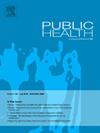Public health funding and chlamydia and gonorrhea rates among adolescents during the COVID-19 pandemic in Ontario, Canada: An interrupted time series study
IF 3.9
3区 医学
Q1 PUBLIC, ENVIRONMENTAL & OCCUPATIONAL HEALTH
引用次数: 0
Abstract
Objectives
We estimated the association between local public health infectious and communicable diseases (ICD) funding and chlamydia and gonorrhea trends before and during the COVID-19 pandemic among adolescents aged 13–19 in Ontario, Canada.
Study design
Quasi-experimental, interrupted time series.
Methods
We conducted a population-based analysis using repeated cross-sectional data of chlamydia and gonorrhea incidence among adolescents across Ontario's 34 regional public health units from January 2015 to October 2022. We used negative binomial-regression to estimate changes in chlamydia and gonorrhea incidence before and during the COVID-19 pandemic, and whether these changes differed by 2019 ICD per capita public health funding.
Results
During the study period, there were 51,230 adolescent cases of chlamydia and 5256 of gonorrhea with most cases in females and older adolescents (age 18–19). Pre-pandemic, chlamydia rates increased over time (Risk ratio (RR) = 1.01, 95 % confidence interval (CI): 1.01–1.01, per month). There was an immediate decrease in chlamydia rates post-pandemic onset (RR = 0.26, 95 % CI: 0.12–0.53) though higher rates were observed with increasing 2019 ICD per capita funding (RR = 1.11, 95 % CI: 1.05–1.17, per dollar of ICD per capita funding, post-pandemic onset). Similar trends were observed for gonorrhea, but estimates had lower precision.
Conclusion
Higher pre-pandemic 2019 ICD per capita funding may have allowed greater sexual health screening services during the COVID-19 pandemic, potentially mitigating a larger drop in STI detection. Results suggest that higher public health funding may allow for greater resilience of sexual health services during public health emergencies.
加拿大安大略省2019冠状病毒病大流行期间,公共卫生资金与青少年衣原体和淋病发病率:一项中断的时间序列研究
目的评估加拿大安大略省13-19岁青少年在COVID-19大流行之前和期间衣原体和淋病流行趋势与当地公共卫生传染病(ICD)资助的关系。研究设计:准实验,中断时间序列。方法利用安大略省34个地区公共卫生单位2015年1月至2022年10月青少年衣原体和淋病发病率的重复横断面数据进行了基于人群的分析。我们使用负二项回归来估计COVID-19大流行之前和期间衣原体和淋病发病率的变化,以及这些变化是否因2019年人均ICD公共卫生资金而不同。结果调查期间共发现青少年衣原体病例51230例,淋病病例5256例,以女性和18-19岁的大龄青少年居多。大流行前,衣原体发病率随着时间的推移而增加(风险比(RR) = 1.01, 95%可信区间(CI): 1.01 - 1.01,每月)。大流行发病后衣原体发病率立即下降(RR = 0.26, 95% CI: 0.12-0.53),尽管随着2019年ICD人均资金的增加,衣原体发病率上升(RR = 1.11, 95% CI: 1.05-1.17,每美元ICD人均资金,大流行发病后)。淋病也有类似的趋势,但估计精度较低。结论:2019年流感大流行前人均ICD经费较高,可能在COVID-19大流行期间提供了更多的性健康筛查服务,从而有可能缓解性传播感染检出率的大幅下降。结果表明,在突发公共卫生事件中,更多的公共卫生资金可能会使性健康服务更有弹性。
本文章由计算机程序翻译,如有差异,请以英文原文为准。
求助全文
约1分钟内获得全文
求助全文
来源期刊

Public Health
医学-公共卫生、环境卫生与职业卫生
CiteScore
7.60
自引率
0.00%
发文量
280
审稿时长
37 days
期刊介绍:
Public Health is an international, multidisciplinary peer-reviewed journal. It publishes original papers, reviews and short reports on all aspects of the science, philosophy, and practice of public health.
 求助内容:
求助内容: 应助结果提醒方式:
应助结果提醒方式:


